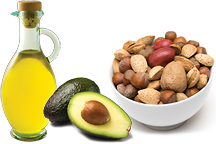Healthy Fats
By Kelly Kwiatkowski
A Simple Guide to Fats Fats, like protein and carbohydrates, are macronutrients used by the body for energy. They support cell growth, protect our organs, produce hormones and aid in absorption of vitamins A, D, E and K, as well as beta-carotene. Fats are either natural or manmade. Manmade trans fats are produced using high temperatures and hydrogenation. Theses fats are solid or semi-solid oils. Many processed foods contain trans fats. Look for partially hydrogenated or hydrogenated oil in the list of ingredients. Margarine, shortening and fried foods contain trans fats. Trans fats can raise total cholesterol and LDL (bad cholesterol) and increase the risk of cardiovascular disease. The American Heart Association recommends you limit trans fat intake to less than 1 percent of your total calories per day (less than 1 gram per 1,000 calories). The two natural groups of fats (from plant- and animal-based foods) are saturated and unsaturated fats. Saturated fats are found in animal and dairy products. These are semi-solid at room temperature. For the most part, these fats are considered unhealthy because they can contribute to heart disease; however, not all saturated fats are bad for you. In fact, the short- and medium-chained saturated fatty acids like butter and coconut oil are examples of saturated fats that pump up your metabolism. Moderation is key, because a high intake of saturated fats of any kind can contribute to heart disease.
 There are two types of unsaturated fats: monounsaturated fats (MUFAs) and polyunsaturated fats (PUFAs). These are healthy fats that remain liquid at room temperature. Some examples are canola, safflower, sesame, olive and fish oils. MUFAs and PUFAs help reduce cholesterol levels and can lower your risk of heart disease. PUFAs provide the essential fatty acids (EFAs) omega-6 and omega-3. These are important nutrients involved in regulating inflammation, providing defense against injury and infection, and essential brain and eye development and function.
There are two types of unsaturated fats: monounsaturated fats (MUFAs) and polyunsaturated fats (PUFAs). These are healthy fats that remain liquid at room temperature. Some examples are canola, safflower, sesame, olive and fish oils. MUFAs and PUFAs help reduce cholesterol levels and can lower your risk of heart disease. PUFAs provide the essential fatty acids (EFAs) omega-6 and omega-3. These are important nutrients involved in regulating inflammation, providing defense against injury and infection, and essential brain and eye development and function. Essential Fatty Acids: Omega-6 and Omega-3 Omega-6 Fatty Acids | Linoleic acid (LA) | Parent of the omega-6 fatty acids, abundant in the food supply | Found in many vegetable oils like safflower, sunflower, corn, peanut and canola | | Gamma-linoleic acid (GLA) | Derivative of linoleic acid, not high enough in the diet | Found in borage oil, blackcurrant seed oil, evening primrose oil | | Arachidonic acid (AA) | Derivative of linoleic acid, abundant in food supply | Found in high amounts in eggs, fish and meat | Omega-3 Fatty Acids | Alpha-linolenic acid (ALA) | Parent of the omega-3 family, the body converts ALA into EPA and DHA | Found in flaxseed, flaxseed oil, hemp oil, nuts, green leafy vegetables and wheat germ | Eicosapentaenoic acid (EPA)
Docosahexaenoic acid (DHA) | Derivatives of ALA | Found in fatty fish like salmon, tuna and mackerel | What Are EFAs? Essential fatty acids are two families of polyunsaturated fats: omega-6 and omega-3. They are called essential because they can't be made by the body and must come from the diet. EFAs have three primary functions. They regulate cellular processes, influence membrane function and integrity, and produce hormones. It's important to get the proper balance of omega-6 fatty acids to omega-3 fatty acids in your diet. Most Americans have high intakes of omega-6s and low intakes of omega-3s, as many processed foods are rich in vegetable oils that contain omega-6 fatty acids. There are three types of omega-6 fatty acids: linoleic acid (LA), gamma-linoleic acid (GLA) and arachidonic acid (AA). Both LA and AA are abundant in the food supply. However, most people don't get enough GLA in their diets. GLA, found in blackcurrant seed oil, borage oil and evening primrose oil, is important in producing cell-signaling molecules called eicosanoids. Eicosanoids help regulate inflammation in the body. Some studies have shown GLA to be beneficial for rheumatoid arthritis, cardiovascular disease, and certain inflammatory skin conditions like eczema or psoriasis. Fats at a Glance Saturated Fats | Types | How does it affect my health? | Examples of foods and oils. | | Short-chain saturated fats | Readily metabolized by the body for energy | Butter, coconut oil, palm kernel oil | | Medium-chain saturated fats | Also metabolized for energy, not associated with raising cholesterol or linked to heart disease | Coconut oil, palm kernel oil | | Long-chain saturated fats | Associated with raising LDL (bad cholesterol) and linked to increased risk of heart disease. Not readily metabolized | Meats, especially red meats | Unsaturated Fats | Types | How does it affect my health? | Examples of foods and oils. | | Monounsaturated fats | Helps to reduce LDL cholesterol, can lower risk of heart disease and stroke, provides nutrients to help develop and maintain the body's cells, typically high in vitamin E | Olive oil, canola oil, peanut oil | | Polyunsaturated fats | Helps to reduce LDL cholesterol, can lower risk of heart disease, provides the essential fats omega-6 and omega-3 which your body can't produce on its own | Corn oil, flaxseed oil, safflower oil, sesame oil, blackcurrant seed oil, borage oil, sunflower oil, evening primrose oil and fatty fish oils | The three omega-3 fatty acids are alpha-linolenic acid (ALA), eicosapentaenoic acid (EPA), and docosahexaenoic acid (DHA). The body converts ALA into EPA and DHA. This conversion requires an enzyme called D-6-D, and research has shown this enzymatic function might be impaired in many people. Another way to get EPA and DHA is directly through the diet. Fatty fish are a rich source of EPA and DHA. DHA is essential for brain and eye development and function. EPA and DHA support cardiovascular health, healthy triglycerides and healthy blood pressure. Large-scale randomized controlled trials suggest DHA and EPA from fish oil lower triglycerides and reduce the risk of death, heart attack, dangerous abnormal heart rhythms, and strokes in people with known cardiovascular disease. EPA and DHA produce eicosanoids, and their inflammation-lowering properties may be the factor involved in the cardiovascular and other health benefits of fish oil. Which Fats and How Much? In its 2005 Dietary Guidelines for Americans, the USDA recommends we get most of our dietary fat from sources containing polyunsaturated or monounsaturated fats. The USDA also recommends we decrease our saturated fatty acid intake and avoid trans fats as much as possible. The American Heart Association suggests all individuals include fish in their diets and people with a history of heart disease take fish oil supplements. As far as fats go, the rule of thumb is to cut down on fried foods and processed foods containing hydrogenated oils whenever we can and increase our use of quality oils like olive oil, canola oil, flaxseed oil, as well as our intake of nuts, seeds and fatty fish.
 By incorporating the right kinds of fats into our diets, we can reduce the risk of developing chronic conditions such as high blood pressure and cholesterol, heart disease and diabetes. So, the next time you're staring down an aisle at the grocery store, wondering what to buy, remember healthy fats are a smart option.
By incorporating the right kinds of fats into our diets, we can reduce the risk of developing chronic conditions such as high blood pressure and cholesterol, heart disease and diabetes. So, the next time you're staring down an aisle at the grocery store, wondering what to buy, remember healthy fats are a smart option. Recommended Fat Intake - Total fat intake for adults should be between 20-35 percent of daily calories.
- Total fat intake for children ages 4-18 years should be between 25-35 percent of daily calories.
- Total fat intake for children ages 2-3 years should be between 30-35 percent of daily calories.
- Less than 10 percent of daily calories should be from saturated fatty acids.
- Maximize the amount of poly- and monounsaturated fats compared to other sources of fat.
- Minimize the amount of saturated fat intake.
- Minimize trans fat intake as much as possible.
- Fat intake greater than 35 percent of calories and increased intake of saturated fat are both associated with higher risk of heart disease.
Source: U.S. Department of Health and Human Services, National Institutes of Health, National Heart, Lung, and Blood Institute
Kelly Kwiatkowski has worked as a communications professional and project manager in the academic and corporate health care research sectors for the past seven years. She currently is a scientific writer for a whole-foods supplement company in Palmyra, Wis.
Page printed from:
http://www.toyourhealth.com/mpacms/tyh/article.php?id=1095&no_paginate=true&no_b=true
|

